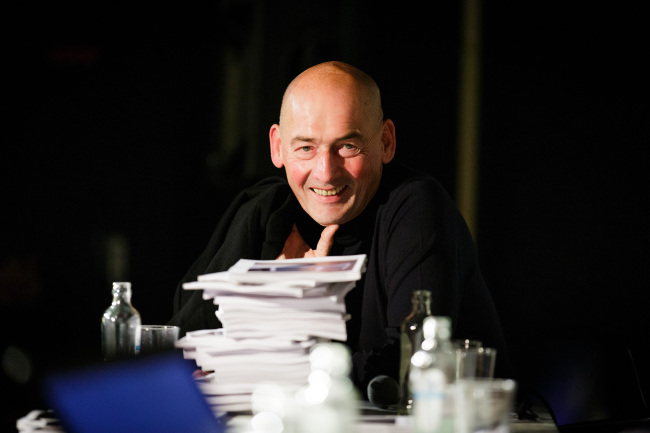MILAN ― An architect with an iconic status around the world, Rem Koolhaas’ cool piercing eyes and tightly pursed lips can intimidate. Sitting outside on the terrace of the ’60s Milan-inspired Bar Luce, created by director Wes Anderson of “The Grand Budapest Hotel” fame, at the Fondazione Prada’s new Milan venue, Koolhaas is busy texting and talking on the phone.
When he is ready for our interview, a day after the media preview, Koolhaas explains with a slight grimace that he cannot shake hands because he broke a rib. His assistant had explained earlier that Koolhaas had been hit by a heavy equipment onsite the day before the opening.
Koolhaas speaks quietly in a calm, even voice, his voice perhaps made softer by the pain in his ribs.
“At the 2012 Venice Biennale, I presented a sort of manifesto suggesting that at this point in architectural history, renovation is as interesting as building new, if not more,” he says. At the press conference the previous day, Koolhaas had said that what he has done with the Fondazione Prada venue is “commonly called renovation.”
Explaining how architecture in the past decade has been defined in an increasingly narrow way, with pressure on extravagance, Koolhaas says, “I don’t feel comfortable in that situation. Preservation and engagement with the past is a good antidote to that.”
 |
Rem Koolhaas (Fred Ernst/OMA) |
The sprawling 19,000-square-meter campus is composed of seven preexisting distillery buildings dating back to 1916, and three new structures by Koolhaas ― the Podium, featuring aluminum foam and large glass windows; the Cinema, which is a multi-activity space with mirrored sides that can open up; and the Torre, currently under construction, which will feature floors of different heights (each floor will be 1 meter taller than the one below). The rest of the preexisting buildings have been preserved in their original form with their plaster facades except for the Haunted House, said to be Miuccia Prada’s favorite for its intimacy, which has been covered in gold leaf, a way to give value this seemingly unimportant building, according to Koolhaas, who explained the inspiration for the move came at the last minute.
“We found here a great variety of spaces and spatial conditions. What we did after analyzing the repertoire was to add to it but not copy any of it. Our ambition became to have a collection of spaces that could have almost the same status as the collection of works of art which would guarantee that there would always be a space suitable or challenging for the art.”
Koolhaas also appreciates the open and public spaces in the venue. “The beauty is that there is an escape from things here,” he says looking at the Podium located across from where we sit.
“I tried to communicate a sense of possibility, unpredictability. For me buildings are tools, and an important part of each of our tools is that it opens space for experimentation and a good tool can be used in many different ways,” Koolhaas says about the Fondazione Prada campus.
That was also the goal for the Leeum, Samsung Museum of Art, which opened in 2004 and features Koolhaas’ work along with those by Mario Botta and Jean Nouvel, he adds.
Transformation appears to be a consistent theme for Koolhaas. “I am obsessed with transformation,” he says. The new buildings for Fondazione Prada have been designed with transformation in mind to allow for various activities. For example, the first floor exhibition space of the Podium, currently all glass, can be curtained off to create a blind room when needed. The sides of the Cinema building open up as well as one side of the Podium that is situated in parallel to the Cinema building, with the possibility of creating a vast open space.
I recall the “The Prada Transformer” exhibition held in Seoul in 2009 featured a unique structure that was rotated using crane to accommodate different activities. “The Transformer was an ultimate fantasy of how each project could be different,” Koolhaas explains.
A child of the ’60s ― a time of rapid social change and revolutions ― Koolhaas admits that his “obsession” with transformation could be traced back to those days. “Our works are deeply influenced by the radicalism of the ’60s,” he says.
Is he out to change the world? Is that why he got into journalism as a young man ― enticed by the possibility of changing the world with words ― and then architecture as a means to change the world by dictating how people live and behave?
Koolhaas chuckles and quickly points out the similarities between journalism and architecture. “Journalism is based on curiosity. In that way I am still a journalist. I have a massive curiosity at the beginning of a project. We need to understand the political culture before we intervene,” he explains. “That interest is still intact,” he says.
As for architecture changing the world, Koolhaas notes that architects introduce irreversible changes but he is not too keen on such changes. “I try to avoid those responsibilities which are too heavy. My interest is to make an improvement,” he says.
“There are certain conditions that can definitely be improved. But personally, I really enjoy it if I not only work with my mission but the mission of the client,” Koolhaas says, citing the example of a new headquarters for Axel Springer, a German publishing company.
“I was asked to deliberately change the culture of the company. They wanted to switch from newspaper to digital working environment. This requires a building that appeals to the digital mentality,” he says.
Dictating how we live and work in our environments through his buildings, Koolhaas is transforming the world one building at a time.
By Kim Hoo-ran (
khooran@heraldcorp.com)
This is the first part of a two-part interview with Rem Koolhaas. ― Ex.








